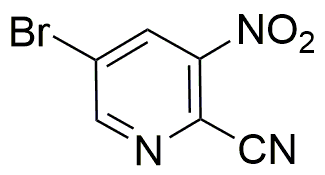5-Bromo-2-cyano-3-nitropyridine is widely utilized in research focused on:
- Pharmaceutical Development: This compound serves as an important intermediate in the synthesis of various pharmaceuticals, particularly in developing drugs targeting neurological disorders.
- Agricultural Chemicals: It is used in the formulation of agrochemicals, contributing to the development of effective pesticides and herbicides that enhance crop protection.
- Material Science: The compound plays a role in creating advanced materials, including polymers and coatings, which are essential in electronics and automotive industries.
- Organic Synthesis: It acts as a versatile building block in organic synthesis, facilitating the creation of complex molecules in laboratory settings.
- Research Applications: Researchers utilize this chemical in various studies, including those focused on reaction mechanisms and the development of new synthetic pathways.
General Information
Properties
Safety and Regulations
Applications
5-Bromo-2-cyano-3-nitropyridine is widely utilized in research focused on:
- Pharmaceutical Development: This compound serves as an important intermediate in the synthesis of various pharmaceuticals, particularly in developing drugs targeting neurological disorders.
- Agricultural Chemicals: It is used in the formulation of agrochemicals, contributing to the development of effective pesticides and herbicides that enhance crop protection.
- Material Science: The compound plays a role in creating advanced materials, including polymers and coatings, which are essential in electronics and automotive industries.
- Organic Synthesis: It acts as a versatile building block in organic synthesis, facilitating the creation of complex molecules in laboratory settings.
- Research Applications: Researchers utilize this chemical in various studies, including those focused on reaction mechanisms and the development of new synthetic pathways.
Documents
Safety Data Sheets (SDS)
The SDS provides comprehensive safety information on handling, storage, and disposal of the product.
Product Specification (PS)
The PS provides a comprehensive breakdown of the product’s properties, including chemical composition, physical state, purity, and storage requirements. It also details acceptable quality ranges and the product's intended applications.
Certificates of Analysis (COA)
Search for Certificates of Analysis (COA) by entering the products Lot Number. Lot and Batch Numbers can be found on a product’s label following the words ‘Lot’ or ‘Batch’.
*Catalog Number
*Lot Number
Certificates Of Origin (COO)
This COO confirms the country where the product was manufactured, and also details the materials and components used in it and whether it is derived from natural, synthetic, or other specific sources. This certificate may be required for customs, trade, and regulatory compliance.
*Catalog Number
*Lot Number
Safety Data Sheets (SDS)
The SDS provides comprehensive safety information on handling, storage, and disposal of the product.
DownloadProduct Specification (PS)
The PS provides a comprehensive breakdown of the product’s properties, including chemical composition, physical state, purity, and storage requirements. It also details acceptable quality ranges and the product's intended applications.
DownloadCertificates of Analysis (COA)
Search for Certificates of Analysis (COA) by entering the products Lot Number. Lot and Batch Numbers can be found on a product’s label following the words ‘Lot’ or ‘Batch’.
*Catalog Number
*Lot Number
Certificates Of Origin (COO)
This COO confirms the country where the product was manufactured, and also details the materials and components used in it and whether it is derived from natural, synthetic, or other specific sources. This certificate may be required for customs, trade, and regulatory compliance.


